Trends in the eCommerce industry are vital for businesses to stay competitive. These trends encompass everything from mobile shopping's rise to the impact of consumer behavior and preferences. Understanding and adapting to these trends can significantly impact the success of eCommerce ventures.
Aloa, an expert in software outsourcing, helps businesses and startups navigate the complex world of eCommerce by offering tailored solutions to meet their specific needs. Our team of professionals understands the importance of staying updated with the latest eCommerce trends and technologies to ensure our clients stay ahead of the competition.
This comprehensive guide will delve into the top trends in eCommerce industry poised to shape the landscape in 2024. Additionally, we'll provide insights into how businesses can leverage these eCommerce trends to enhance the shopping experience, optimize checkout processes, and engage customers effectively.
At the end of this blog, you will clearly understand the trends driving the eCommerce industry and actionable strategies to position your business for success in the ever-evolving digital marketplace. Stay tuned to discover the latest insights and innovations that will shape the future of eCommerce.
Let's dive in!
8 Trends In eCommerce Industry To Watch and Leverage in 2024
Understanding the latest trends in the eCommerce industry is crucial for businesses looking to stay competitive in the digital marketplace. Explore and leverage the latest trends in eCommerce industry for 2024. Keep an eye on these eight key trends to stay ahead and innovative in this dynamic market.

1. Mobile eCommerce
Mobile eCommerce, commonly known as m-commerce, refers to buying and selling goods and services using mobile devices like smartphones and tablets. This trend in the eCommerce industry has seen remarkable growth in recent years, with mobile devices becoming the preferred choice for online shopping.
Statista's Market Insights states that mobile eCommerce sales reached an astounding $2.2 trillion in 2024, constituting 60 percent of total global eCommerce sales. This figure is projected to rise further, with an expected 62 percent share in 2027 and a whopping $3.4 trillion in sales. The exponential growth of mobile eCommerce underscores its importance in the eCommerce industry.

Consumers' growing reliance on mobile devices for shopping, combined with its convenience, makes mobile eCommerce a trend that businesses must pay attention to. Adapting to these trends in the eCommerce industry involves optimizing websites and apps for mobile users, ensuring a seamless shopping experience on smaller screens, and embracing mobile-specific marketing strategies.
Potential Impact of Mobile eCommerce
- Increased Convenience: Mobile eCommerce offers unparalleled convenience, allowing consumers to shop anytime and anywhere. This accessibility leads to higher engagement and conversion rates, benefiting businesses.
- Expanding Global Reach: With mobile devices in the hands of a global audience, businesses can reach a broader customer base. These trends in the eCommerce industry are breaking down geographical barriers and opening up new markets.
- Enhanced User Experience: Mobile apps and websites continually improve user interfaces and experiences. This not only attracts more users but also enhances customer satisfaction and loyalty.
- Data-Driven Insights: Mobile eCommerce platforms collect vast amounts of data on user behavior. This data can be leveraged for personalized marketing, product recommendations, and overall shopping experience optimization.
2. Voice Commerce
Voice commerce is the use of voice commands to execute purchasing activities online. It's one of the emerging trends in the eCommerce industry, making it easier for users to shop without the need for a traditional web interface. The voice commerce market is expected to grow by 55.68 billion USD between 2021 and 2026, boasting a CAGR of 24.34%.
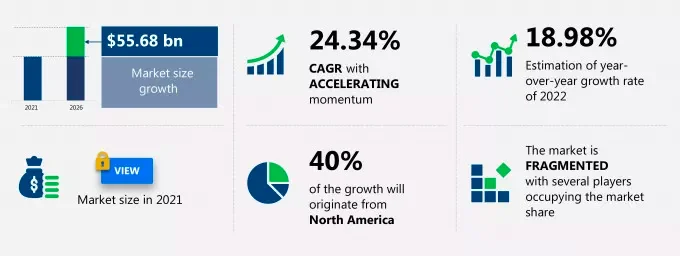
While voice commerce offers many benefits, it has challenges like data privacy and security breaches. Nonetheless, it is one of the top trends in the eCommerce industry, significantly impacting online retail and customer experience. Especially in the post-COVID-19 era, companies that integrate voice commerce into their operations stand to gain a competitive edge, according to market research reports.
With the rise in smart speakers and other voice-enabled devices, these trends in the eCommerce industry are set to revolutionize retail sales and shape the future of the eCommerce platform.
Potential Impact of Voice Commerce
- Enhanced Convenience: Voice commerce simplifies shopping, eliminating the need to navigate cumbersome eCommerce sites.
- Increased Sales: The ease of use in voice commerce can translate into higher retail sales for eCommerce businesses.
- Improved Customer Experience: Companies adopting this technology can significantly improve customer shopping experience.
- Expanding Markets: Voice commerce is set to hit smart speakers and vehicle dashboards, thus widening the reach of online retail.
3. Headless Commerce
Headless Commerce separates the front-end presentation layer from the back-end commerce functionalities, allowing for more flexible and customized consumer experiences. According to Smart Insights, businesses adopting trends in the eCommerce industry can integrate various channels into the customer lifecycle more efficiently.
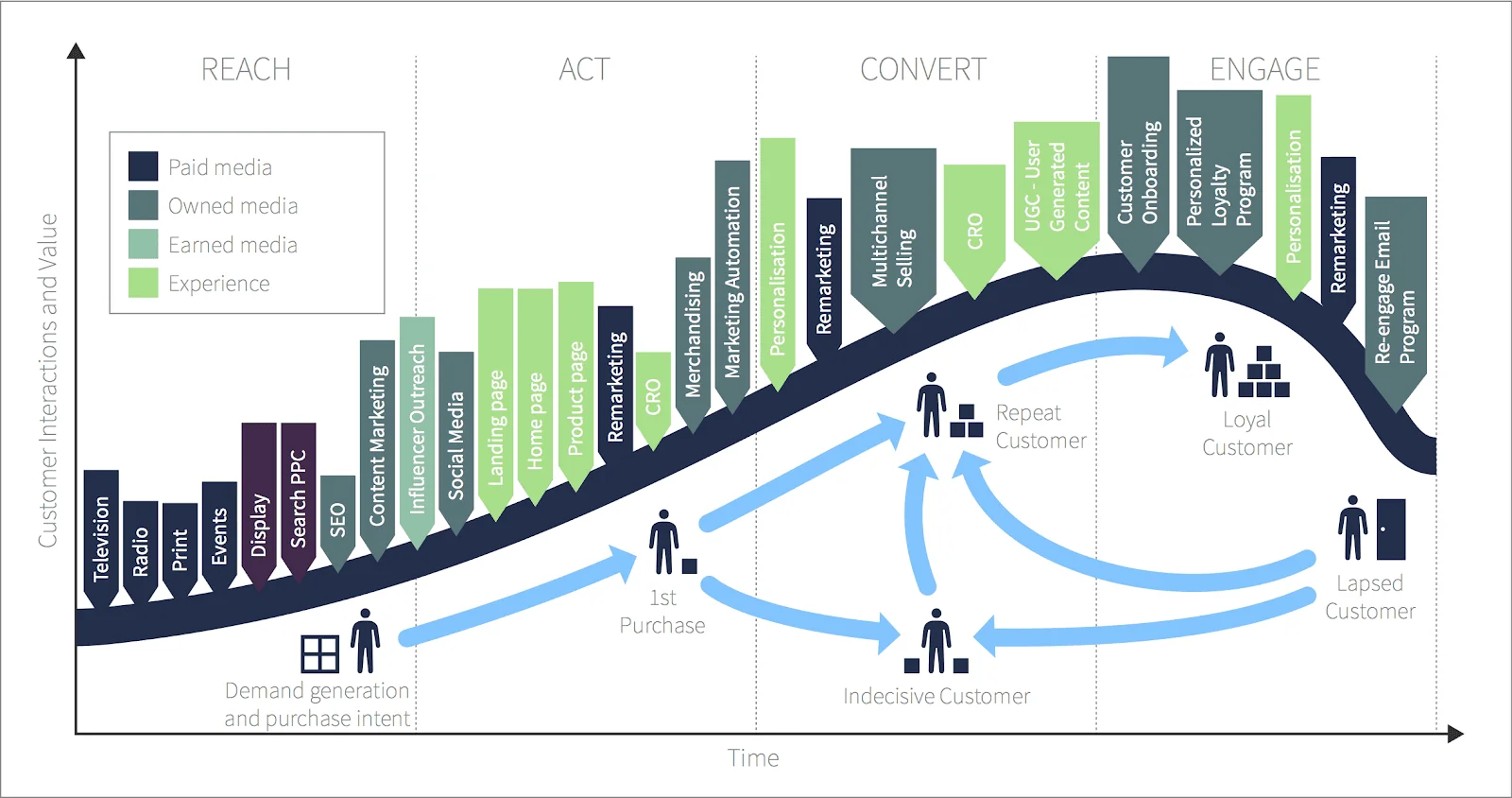
Referencing that headless commerce makes integration seamless, businesses can add their brand to new devices or platforms in hours rather than months. This model dismantles the operational silos often found in traditional ecommerce platforms that hinder downstream integrations like social media platforms or native apps.
Instead of adopting a rigid, standard ecommerce system, now is the opportune moment to pivot toward a headless commerce approach. Doing so equips your business with the agility to incorporate top trends in the eCommerce industry easily and keeps you ahead in the competitive online retail landscape.
Potential Impact of Headless Commerce
- Speed and Agility: Headless commerce reduces the time required to implement changes, allowing businesses to rapidly adapt to the latest trends in the eCommerce industry.
- Multi-Platform Integration: Brands can easily integrate their offerings with platforms like social media, including Facebook and Instagram, and even new devices like Google Home.
- Enhanced Customer Experience: With more accessible integration capabilities, ecommerce businesses can offer live chat, customer support, and other features more seamlessly, elevating the overall customer experience.
- Cost Efficiency: Headless commerce negates the need for extensive redevelopment when adding new front-end solutions, saving time and money.
4. Live Commerce
Live Commerce integrates real-time video streaming with online shopping, offering an interactive and immersive customer experience. According to a 2022 survey by Statista, 31% of respondents claimed that live commerce helped them make more informed buying decisions and access exclusive discounts.
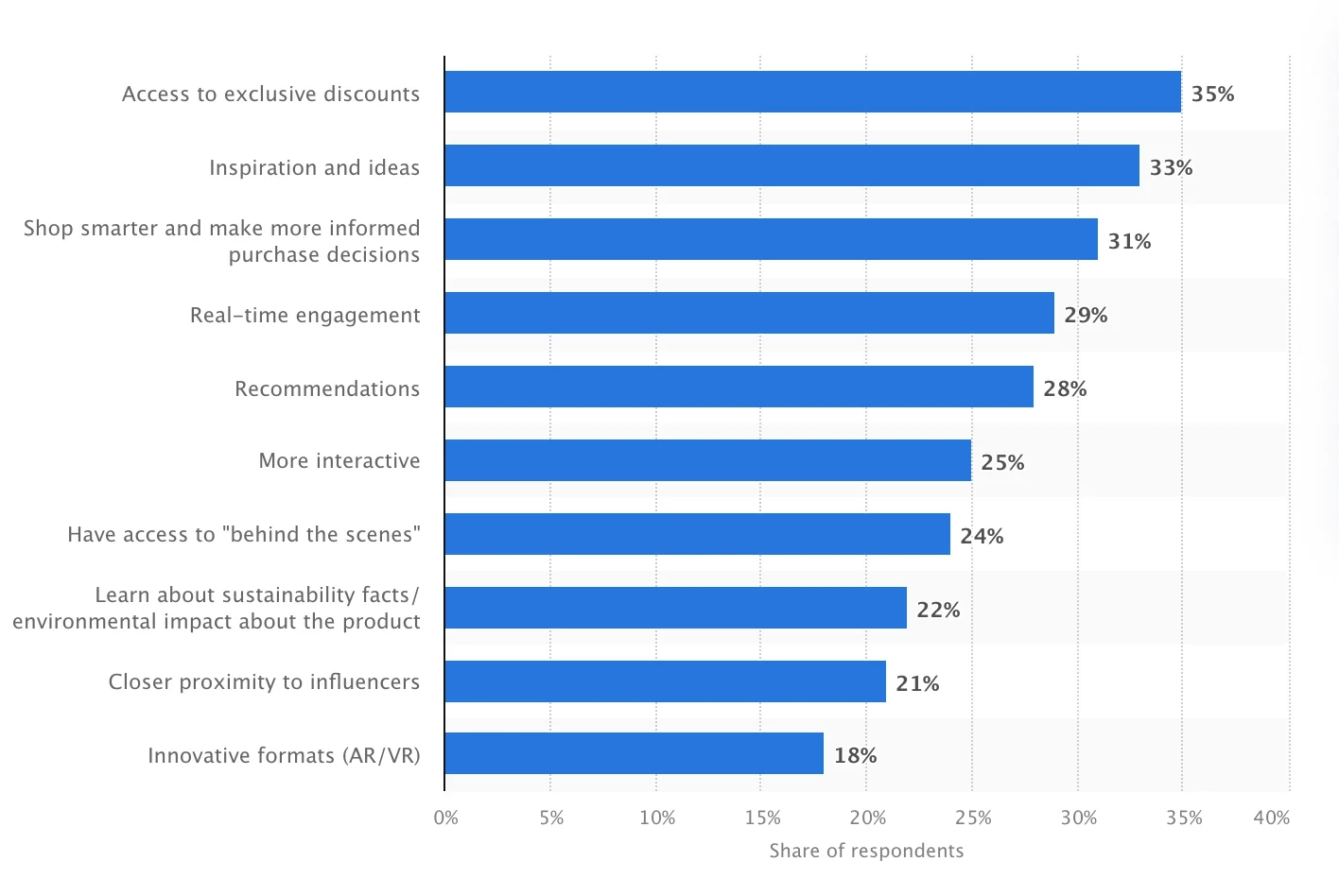
Live commerce is a great way to blend social media and online retail. As one of the top trends in the eCommerce industry, it has the potential to reshape customer experience and serve as a driving force in the ecommerce industry's evolution.
Potential Impact of Live Commerce
- Enhances Customer Engagement: Live commerce fosters real-time interaction between the brand and the customer, making shopping more personalized and engaging.
- Boosts Retail Sales: With the immediate availability of customer support and live chat, potential customers are more likely to convert, boosting retail sales.
- Increases Annual Growth Rate: As one of the latest trends in the eCommerce industry, live commerce has the potential to significantly accelerate the annual growth rate of ecommerce businesses.
- Elevates Customer Experience: By leveraging social media platforms like Facebook and Instagram, live commerce offers a multi-faceted, interactive shopping experience, setting it apart from traditional online retail and mortar stores.
5. Social Commerce
Social commerce is one of the rapidly growing trends in the eCommerce industry. Promoting and selling products and services through social networking sites like Facebook, Instagram, and Twitter. In 2021, the global social commerce market reached an impressive $0.62 trillion and is projected to skyrocket to $7.03 trillion by 2030, showcasing a remarkable CAGR of 30.8% over the decade.
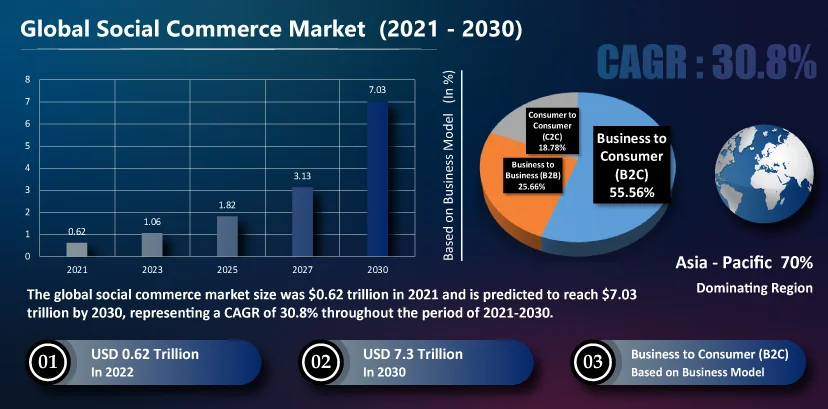
One of the critical impacts of the social commerce trend is the tremendous market growth it offers. The exponential increase from $0.62 trillion to $7.03 trillion in less than a decade is a testament to the industry's potential.
Potential Impact of Social Commerce
- Increased Sales: Social commerce leverages social media platforms like Facebook, Instagram, and Twitter to promote and sell products, expanding sales channels and reaching a broader audience. By crafting engaging Facebook captions and using visually appealing content on Instagram, businesses can effectively capture the attention of their target audience.
- Enhanced Engagement: Consumer participation through likes, shares, and retweets on social media contributes to the effectiveness of social commerce efforts, fostering engagement and brand loyalty. By choosing to embed Instagram feed on website platforms, brands can further enhance engagement and reinforce customer loyalty, as it seamlessly integrates social proof into their online presence.
- Sustainability: Social commerce aligns with sustainability trends in the eCommerce industry, allowing businesses to showcase sustainable offerings and attract environmentally conscious consumers.
- Privacy Concerns: However, increasing privacy concerns, including data security and tracking issues, pose challenges to the social commerce market's growth.
6. Omnichannel Retail
Omnichannel retail is one of the pivotal trends in the eCommerce industry in the eCommerce industry, driven by the ever-evolving consumer landscape and accelerated by the COVID-19 pandemic. According to Statista, nearly half of eCommerce decision-makers in Europe and North America considered omnichannel strategies very important in 2021.
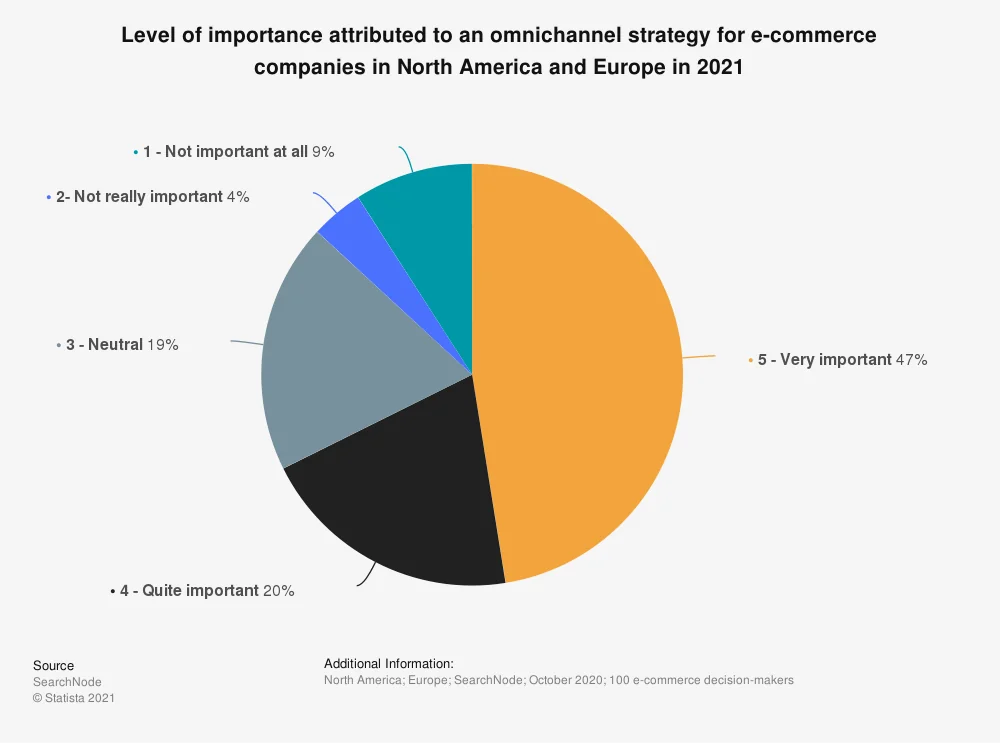
Unlike in the past, where consumers used two touchpoints on average, today's shoppers engage with almost six touchpoints before making a purchase decision. UC today's study reveals that nearly 90% of consumers now seek an omnichannel experience. What was once a convenience has become an expectation and, in some cases, a demand.
The rapid transformation of consumer behavior in 2020 underscored the importance of omnichannel strategies. Research by BigCommerce and Retail Dive in 2020 showed that 46% of retail executives planned to increase their investment in commerce retailing post-COVID-19, emphasizing convenience as a critical driver.
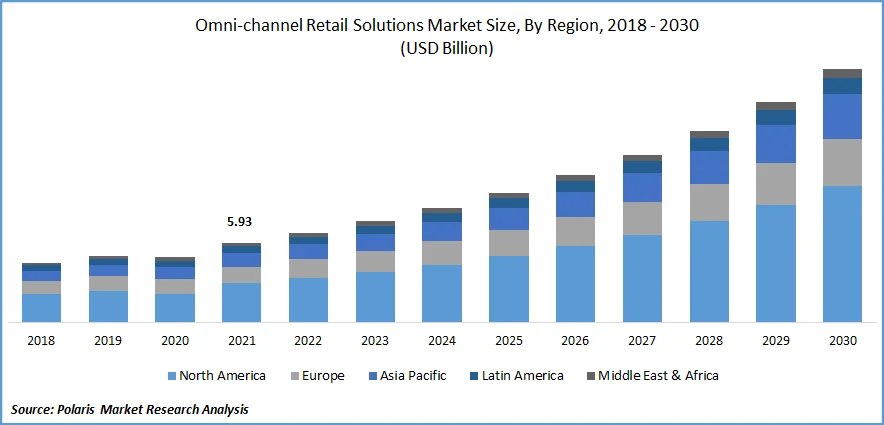
In 2021, the Omni-channel retail solutions market held a value of USD 5.93 billion and is projected to achieve a 13.8% CAGR throughout the forecasted period. Omni-channel retail software aims to ensure a smooth shopping experience for customers, bridging physical stores and online marketplaces seamlessly.
Potential Impact of Omnichannel Retail
- Increased Sales and Profitability: Omnichannel strategies can drive higher sales and profitability by providing a convenient and seamless shopping experience across multiple channels.
- Stand Out in a Crowded Market: As competition in online retail intensifies, adopting an omnichannel approach sets businesses apart, offering a superior shopping experience and service.
- Optimized Business with Data: Data and analytics are crucial in optimizing operations. Centralizing data from various sources helps balance inventory, tailor marketing efforts, and provide better service.
- Personalization: Omnichannel retail allows businesses to collect data from multiple touchpoints, enabling personalized experiences that make customers feel valued and cater to their interests.
7. AI and Personalization
AI and personalization involve leveraging artificial intelligence technologies to tailor user experiences in eCommerce. It's about using data and algorithms to deliver highly customized content, product recommendations, and search results to individual users.
AI and personalization are pivotal trends in eCommerce industry. A survey conducted in October 2020 revealed that 70% of North American and European eCommerce decision-makers anticipated that AI would be crucial in enhancing personalization in 2021. Additionally, 54% of these executives hoped AI would improve their site search capabilities. Only a minimal 4% did not believe that AI would benefit their companies in this context. With the rise of AI for retail, businesses are finding innovative ways to better serve customers by predicting preferences and improving the overall shopping experience.
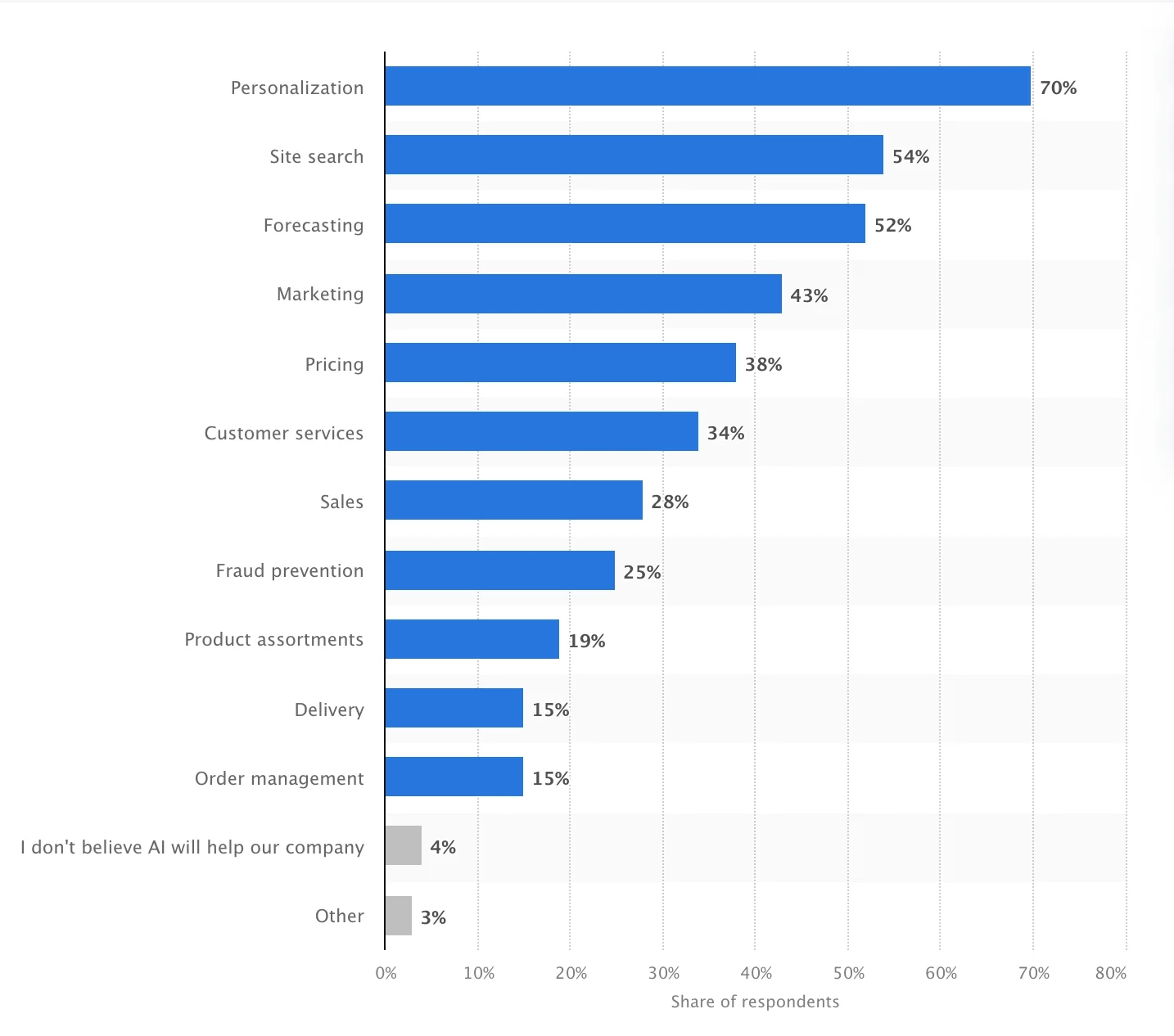
As of 2021, website personalization, valued at USD 386.62 million, has continued its upward trajectory, reshaping how businesses engage with customers. It involves tailoring content and offers to specific customer segments, enhancing new visitor conversions and customer retention rates.
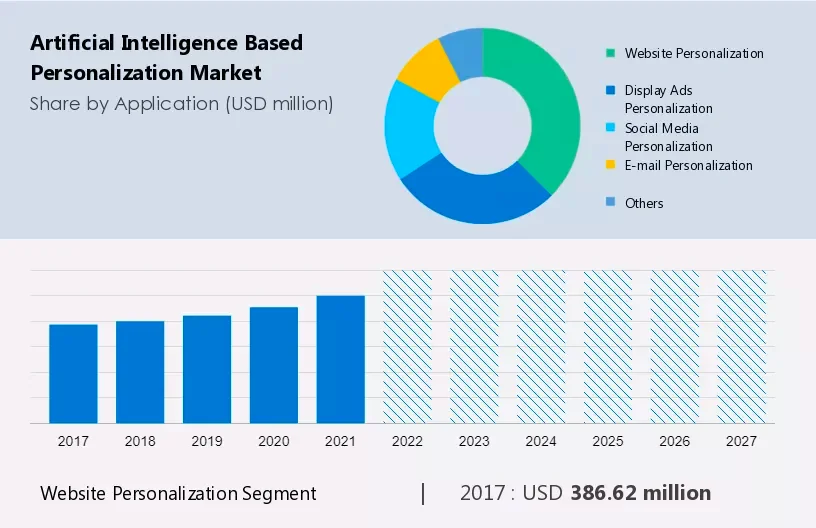
Potential Impact of AI and Personalization
- Enhanced Customer Experiences: AI-driven personalization enables businesses to provide highly relevant product recommendations and content, improving user experiences.
- Increased Conversion Rates: By tailoring content and product suggestions to individual preferences, AI-driven personalization can significantly boost conversion rates, turning more visitors into customers.
- Efficient Retention Strategies: Personalization helps retain existing customers by consistently delivering content and offers that match their interests and buying history.
- Data-Driven Decision Making: AI-powered personalization relies on data analysis to make informed decisions about content and product recommendations, allowing businesses to stay agile and responsive to changing customer preferences.
8. Augmented Reality (AR) and Virtual Reality (VR)
Augmented Reality (AR) and Virtual Reality (VR) are transformative technologies reshaping eCommerce. Goldman Sachs predicts that this industry will achieve an annual value of $80 billion by 2025, with $35 billion allocated to software and $45 billion to hardware. AR enhances real-world experiences by overlaying digital information and objects onto the physical world, while VR immerses users in entirely virtual environments.
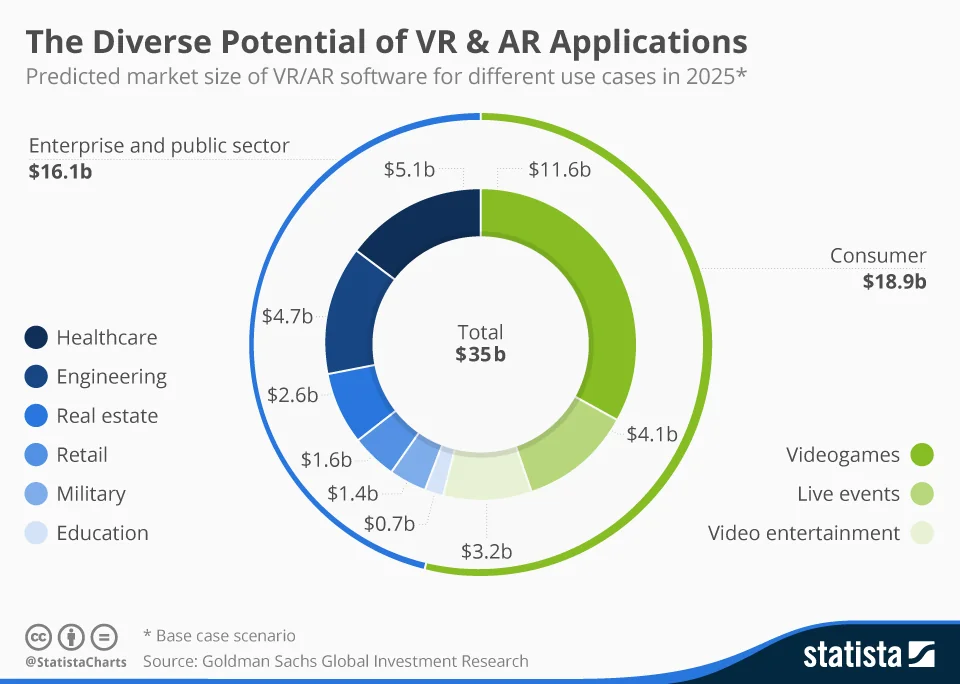
Goldman Sachs identifies video gaming, live events, and video entertainment as the most promising consumer-focused AR/VR technology applications. These technologies transform online shopping and extend their benefits to diverse sectors like healthcare and education. As eCommerce continues to evolve, AR and VR are poised to enhance customer experiences and drive business growth significantly.
Potential Impact of AR and VR
- Enhanced Shopping Experiences: AR and VR offer immersive product visualization, allowing customers to "try before they buy" and explore products virtually, boosting confidence in online purchases.
- Improved Customer Engagement: Interactive AR and VR experiences captivate customers, increasing engagement and reducing bounce rates on eCommerce websites.
- Enterprise Applications: Nearly half of the AR/VR industry's revenue is expected to come from the enterprise and public sector. In healthcare, for example, these technologies can aid in medical training, surgery simulations, and remote consultations, enhancing patient care.
- Innovation in Education: AR and VR have the potential to revolutionize education, enabling immersive learning experiences and remote education opportunities.
How to Stay Ahead of the Curve In eCommerce Trends
Understanding and adapting to the latest trends in eCommerce industry can be the determining factor between achieving success or facing stagnation. Let's now delve into six essential strategies that will enable your eCommerce business to maintain a leading position in industry trends.
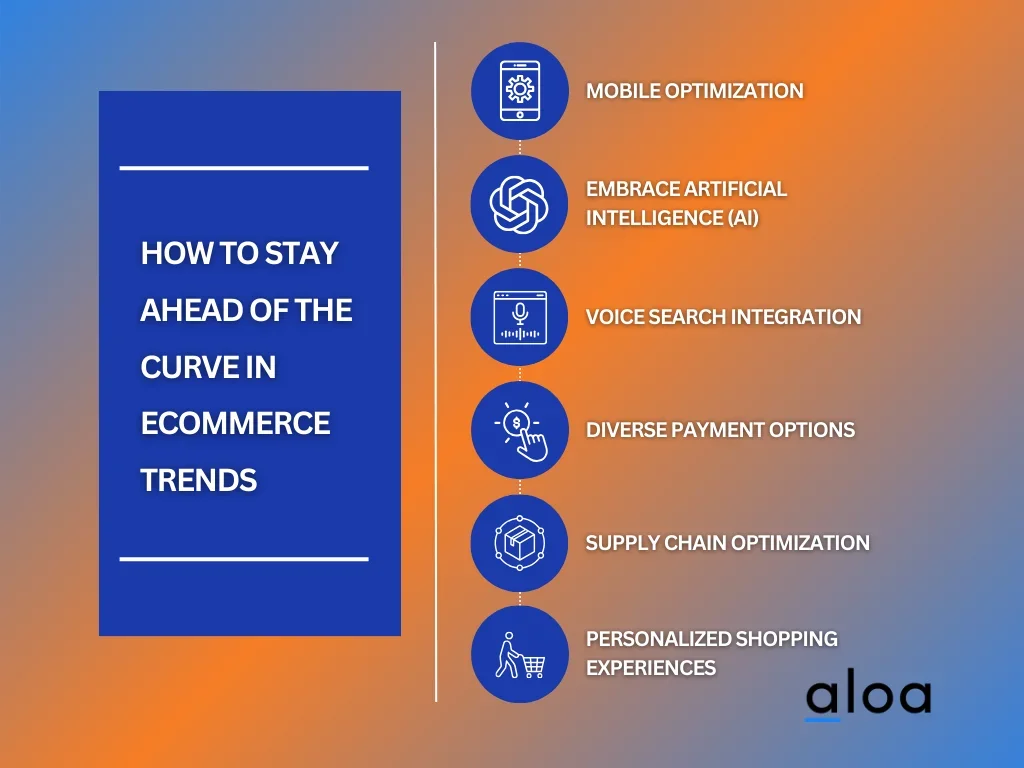
Mobile Optimization
As mobile shopping continues to gain momentum, it becomes essential to prioritize optimizing your e-commerce website and mobile app for mobile devices. A responsive site offering seamless experience on smartphones and tablets is crucial. Not only does mobile optimization enhance the customer journey, but it also boosts conversion rates.
Embrace Artificial Intelligence (AI)
AI, encompassing machine learning and chatbots, is crucial in enhancing customer service and personalization. By implementing AI-powered chatbots, businesses can offer real-time assistance to online shoppers. Moreover, machine learning enables customer data analysis and facilitates personalized product recommendations.
Voice Search Integration
Voice search has revolutionized how consumers discover products online. It's crucial to optimize your eCommerce platform for voice search, enabling customers to make purchases using voice commands effortlessly. Notably, Amazon's Alexa and Google Assistant have gained immense popularity as voice assistants for online shopping.
Diverse Payment Options
To meet the diverse preferences of customers, offering a range of payment methods is crucial. In addition to traditional credit card payments, integrating digital wallets like Apple Pay and Google Wallet can provide secure and convenient options. By providing these varied payment choices, customer satisfaction and conversion rates can be enhanced.
Supply Chain Optimization
Efficient supply chain management is vital in ensuring prompt deliveries and customer satisfaction. Consider integrating AI in supply chain operations to assist real-time tracking and other automation tasks. Timely delivery is critical for retaining existing customers and attracting new ones.
Personalized Shopping Experiences
To enhance the shopping experience, customize your eCommerce platform. Gain insights into customer preferences and behavior through big data analytics. Employ tactics like personalized product recommendations, targeted email marketing, and influencer marketing to establish a strong connection with your audience.
Key Takeaway
Keeping a pulse on trends in eCommerce industry is crucial, creating both challenges and opportunities for businesses. Optimizing customer service and online store experiences is paramount, with consumers increasingly favoring online shopping. Streamlining shipping processes, reducing friction in checkout, and offering various payment methods, including digital wallets, can significantly improve conversion rates.
Ecommerce businesses must adapt quickly to stay competitive amidst changing trends in the industry. Moreover, leveraging email marketing and harnessing the power of search engines to attract new customers remains vital. Integrating emerging technologies, such as blockchain and the Internet of Things, can revolutionize online shopping experiences.
Don't miss out on these opportunities—implement these trends in the eCommerce industry to thrive in the landscape in 2024 and beyond. Stay agile, stay informed, and stay competitive in eCommerce. For more insights, reach out to [email protected].

